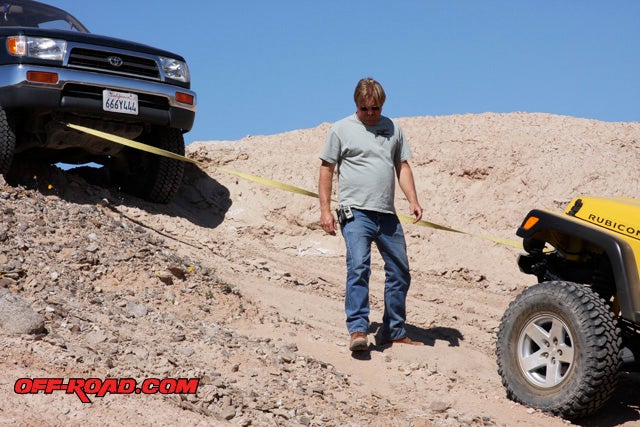
Have you ever reached for your one-size-fits-all tow strap and wondered whether you’re using the right one? There are straps, chain, cable, hooks, loops, sheathing, poly, nylon, rope, and a dozen other ways to tie one vehicle to another for the sake of giving it a pull, and some are more right than others.
Expert Advice
We interviewed two authorities in off-road recovery who we’ve run into repeatedly at off-road shows and in the dirt. Bryan Hubbard from UDS Hardware (310.715.1356 – www.udshardware.com) talked us through some of the elemental physics of straps and what should be kept in mind when working with them. Extreme Outback Product’s George Carousos (866.447.7711 – www.extremeoutback.com) was our second go-to guy, revealing his voluminous practical knowledge of the build-process, methods for each sort of strapping, as well as some details of the traditional stuff. We’re not playing favorites – both guys know their stuff and are great resources for recovery equipment solutions. We’ve bought products from both.
What’s In a Strap?
The two ubiquitous towing/jerking/tugging strap-like devices you’ll see nowadays are made primarily with synthetics – polyester or nylon. The core difference between the two is how they behave under load. Polyester doesn’t stretch much, perhaps 2-3% at 100% tug. This makes for a predictable pull, and poly can endure towing a vehicle for some distance. It’s also safer at its limit because it doesn’t recoil – there’s nothing to snap back because it doesn’t stretch. Nylon has give built into it and is not braided but bundled to allow stretch without twist. Its resilience permits the pulling vehicle to obtain momentum to aid in the tug. Of course, this means stored energy and some risk. Both are useful for different reasons.
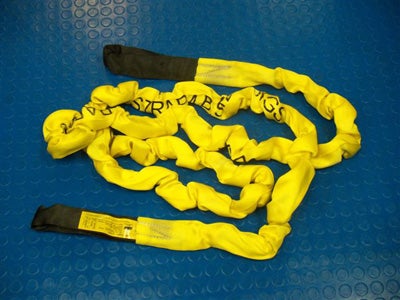 |
| Extreme Outback’s hybrid bungee’d poly strap is fully sheathed and collapses when unloaded to reduce dragging and obstacle hangup. |
Proper Pulling for Polyester
Polyester straps are ideal when you need a slow, exact extraction, as when working with vehicles in the rocks, with good traction, or when the pulling vehicle can creep. Of course, there are variations. If you need to visualize the use of a poly strap, it’s going to work much like a chain.
If there’s a strap that you see most often, it’s the polyester jerk strap. You can call it that because you’ll get a jerk when it goes taught – poly has very little stretch to it, in most cases less than one foot of stretch for 30 feet of strap, at full capacity.
“Poly is not always ideal,” Hubbard told us. “But if there’s one strap to have in the back of your truck, it’s polyester.”
Carousos agrees, saying, “If you want the right strap, buy one for where you usually are – rocks, sand, mud, snow, trees, whatever – or buy one of each and be right all the time. Poly is best if you just want one, because it’s a little more universal.”
Why is it more universal? Because polyester will do more than one job. Extracting and towing, polyester is also used for tree-savers, frame-loops and as a core component of most synthetic winch cables. “Look for a poly strap that has no stitching at the ends,” Hubbard said. A poly strap will be stronger pound-for-pound, and far less lethal in the case of breakage. Poly is also more durable than nylon, and it copes better with abrasion of the rock/cement/sand variety. Like most things, it’s going to lose strength with constant exposure to the sun, so find a breathable storage bag for it.
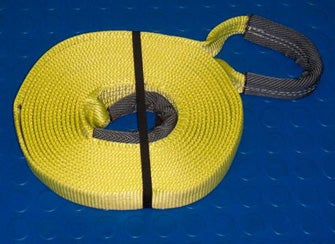 |
| Nylon straps like Extreme Outback’s 30-footer looks like a poly strap – know what you’re using so you can use it properly. |
Elastic Extraction with Nylon
Call it a snatch-strap or a kinetic strap. It behaves like a rubber band. Connect your hands with one and pull the left away from the right. You get some stretch, and then the pressure increases on the right and it’s forced to follow. When traction is lousy – snow, sand, loose gravel, ice, mud – the snatch-strap is best because it allows for what Carousos calls “a running tug.” A snatch-strap is also useful for low-power vehicles that don’t have the mustard to tug from a standstill.
Made mostly of nylon, the elasticity built into a snatch-strap allows a running start without the typical bang of a jerk strap, preserving the sanctity of core parts like frames, bumpers and other tow-points, as well as keeping the tow vehicle from getting stuck. Conversely, that same capacity for stretching makes the snatch-strap lethal if used improperly. Don’t be stupid.
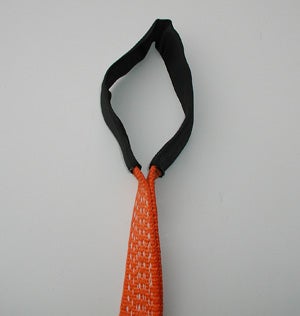 |
| UDS uses sheathing around the strapping and stitching that doesn’t enter the load zone – this is important to protect the hardest working area of the strap. |
We’ve had the poly straps break on us before, sometimes with two vehicles at full-pull, and the only hazard was the vehicle getting away. Poly doesn’t have much capacity to hurt you – though the vehicle being towed does. With a snatch-strap, if it comes loose, all the load-energy between the towing and towed vehicles is translated into recoil. You don’t want to be around for that, so correct use is essential.
Another weakness of a nylon snatch-strap is its … weakness. You can’t haul for a distance with nylon because you’ll destroy the material. Just like a rubber band, if you keep a snatch-strap stretched to the max for too long, it won’t come back. Also, nylon is susceptible to UV-fatigue, vulnerable to abrasion, and if it’s been cut, throw it away.
There is a hybrid snatch/tow strap we found at Extreme Outback that combines helpful characteristics of a nylon-based snatch and the safety and strength of a polyester strap. Usually called a towing strap, a loose bundle of polyester strands is contained within a sleeve/jacket that’s lining is interwoven with nylon bungees. It pulls like poly but recoils like nylon. Most importantly, it has the loaded behavior of poly and only carries about 1-2% stretch fully loaded.
PAGE 3
Keep the NOs in Mind
Some particularly big NOs that come up when talking pulling and straps need to be mentioned to keep the guilt of killing readers off our backs. Stay away from hooks, sewn into the strap or otherwise – they’re going to be found in cheap or old straps and cables. They work, but they also have a propensity for coming off their hook-point and they can break. It’s less an issue with poly straps and chain because the stretch is minimal, but with elastic nylon, softer cables and anything with a capacity for stretch, a hook can open the door for spectacular cases of recoil that will – it’s documented, baby – kill people.
Another NO that not everyone knows is the trailer ball hitch point – never use that for a tie-off because the same potential for explosive separation with hooks can occur with the ball. In reality, if you need a tie-off, it had better be a closed loop that will keep the strap/chain/cable fixed. Ideally, all tow-points need to be like an “O,” “D” or “P” shape, and not a “J” or “C” or “G.” shape. Tie your trucks closed loop to closed loop.
Speaking of loops, don’t connect two straps together with D-rings or frame shackles. Those are for strap-to-frame connection, recovery points, the hitch, the crossmember or frame-secure bumpers with a tow-point.
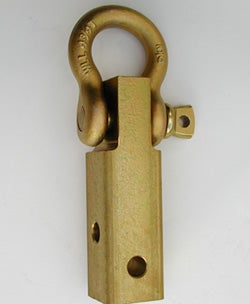 |
| UDS retails a four-position hitch-shackle that is ideal for working with straps – shackles like this make straps easy. |
Everyone has ‘em in their rollaways, or rattling around the bed of the truck. Chain, cable, old-school and nasty. Watch out for old-school features like hooks, or the ravages of age like corrosion or vagrant strands. Hooks aren’t so bad with a chain because a good chain won’t deform, but they can be a pain if they get knotted up in cable. This is not to say they’re bad. In fact, if you can prove the strength, they’re great in particular circumstances.
“Chain is a great problem solver,” Extreme Outback’s Carousos says. Keep 10 or 20 feet of it around for stuff like lifting engines or when you need to make an accurate tug. Crucial to using chain is guaranteeing its strength.
“Use minimum grade 70 transport chain,” Carousos says. “It’s the recovery standard. Most of the G70 stuff is gold-zinc plated, and all the hooks need to be stamped that way – G70. You might not find stamps on chain, so check where you bought it. Forged is good, but G70 is essential.”
G70 is the same chain used to tie a bulldozer to a flatbed, so it’s up to the job. Carousos also warned about knockoff Chinese chain – be careful what you buy. Cheap chain will stretch, and remember that when it stretches it’ll give that energy back. Also, if a link comes apart under load, it can become a missile in search of a soft spot.
 |
| UDS straps are border-stitched to reduce intrusion in the case of a cut. |
If you need to loop it, a high-strength bolt will work, but a set of proper D-rings is better. Hooks? Again, a no-no, but they happen to be a part of lots of old chain. Use them at your own risk. The downsides to a good section of links are obvious – bulky, heavy, noisy, retro.
Cable, on the other hand, is a lot to handle. It’s hard to coil, tricky to work with, and is best wrapped around a winch reel. The cable usually found for recovery applications is not a strong as a poly strap. Protect your hands – use leather gloves with some real thickness – when you handle cable. Same caveats for hooks apply to cable, and if you get cable tangled around something it’s sometimes impossible to unwind. Most folks advise you throw away any cable in doubt: a good poly strap is an inexpensive replacement.
There is a ton of information about recovery gear: this story is just a primer for polyester jerk-straps, nylon snatch-straps, chains and cables. Experts like Bryan and George know more, so give them a call. Stay tuned: we’ll explore body mounts, frame points, D-rings, shackles and other ways to hook your vehicle, and bring you details on how to use it all.


 Your Privacy Choices
Your Privacy Choices